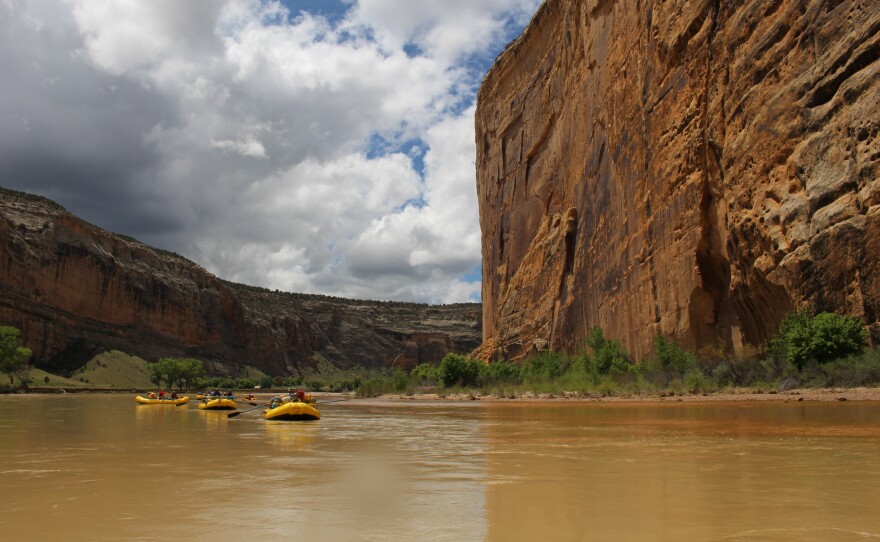Finding a river in the West that still behaves like a Western river — one that rises and falls with the annual rush of melting snow — is tough.
Many of the region’s major streams are controlled by dams. Their flows come at the push of a button. Instead of experiencing dynamic flows, dammed rivers are evened out. Floods are mitigated and managed, seen as a natural disaster rather than an ecological necessity.
But one major Western waterway has achieved almost mythical status for its wildness: the Yampa in northwestern Colorado. As climate change intensifies, and water in the West grows more scarce, those who depend on the river are left wondering how best to protect it.
“It's a different story every time”
On a narrow beach inside the Yampa’s picturesque canyon through Dinosaur National Monument, guides hammer stakes to keep seven yellow inflatable rafts from drifting downstream. Within eyeshot, whitewater is churning, sending an ominous roar up the towering sandstone walls.
“What we're doing is we're scouting the rapid and when we scout a rapid and we basically come down to get a different perspective,” said John Saunders, a river guide and an instructor at Colorado Mountain College, while perched on a rocky outcropping.

Saunders points out the features of Warm Springs, one of the river’s more technical sections. His wavy white hair is tucked into a helmet. He sports a small silver earring in one ear.
The river is beige and roiling, like a latte in a blender on high speed.
“As the water comes around the corner you start to see waves picking up,” Saunders said. “They're not predictable. They're crashing. You've got foam piles and haystacks on top of the waves.
“It looks intimidating.”
Saunders is helping guide this five-day trip down the Yampa. It’s organized by conservation groups — American Rivers and Friends of the Yampa — and the whitewater outfitter OARS. American Rivers receives funding from the Walton Family Foundation, which also provides support for KUNC’s Colorado River coverage.
About 30 people — including water professionals, scientists, elected officials and journalists from across the Colorado River Basin — are getting are getting up close and personal with the Yampa.
RELATED: In Colorado River’s Final Hundred Miles, Small Signs Of Life Return
A seasoned river runner, Saunders has made this trip more than 10 times, and said this frenzied stretch never looks the same.
“It's a different story every time we come,” he said.
This rapid is a good illustration of what makes the Yampa so unique. It changes day to day.

That might sound like a small detail, but its variability is a defining feature, making the Yampa one of the last of a breed. The river is fed by small reservoirs in its headwaters. Scientists say they’re not large enough to significantly change the river’s flow, and it still holds a semblance of the river that existed before people showed up.
“This river is a relic in some ways,” said Kent Vertrees, the Friends of the Yampa board chair.
We chatted in collapsible chairs at a narrow campsite called Compromise after a cold, rainy day on the river. It’s a fitting title given the growing pressures on not just the Yampa, but rivers all across the West.
“In today's world, where most rivers have been dammed, diverted and dewatered to the point where they're not functioning as rivers do or used to,” Vertrees said. “This river still has that functionality.”

That’s not an accident. It comes despite varying interests — cities, farmers, recreationalists, energy companies — all wanting a piece of the river. Every so often water planners’ eyes turn toward the Yampa’s water-rich channel, seeing its untamed flow as something to be siphoned for human use.
“We do have a lot of growth happening in Colorado and all of the states in the Colorado basin,” Vertrees said. “We've been far enough away to this point to preserve the flows of the Yampa. There have been projects that have come up in this area, and none of them have stuck.”
For example, environmental groups stymied an effort to dam the river in the 1950s. The proposal was part of a broader effort to build large-scale water storage in the Colorado River basin. More recent plans to pipe the river’s water to Colorado’s fast-growing Front Range through a project called the Yampa River Pumpback has led to a whole new resurgence in activism around the Yampa, Vertrees said. The trucker hat he wears sports the phrase, “Wild and Free.”
“We protect lands. We protect rivers. Can we continue to protect this river for a variety of reasons and protect those flows? I'd like to think we can,” Vertrees said.

“It had never happened before”
While the Yampa had one of its highest flows in years this spring and summer, it was a different story in the record-breaking hot and dry summer of 2018.
Erin Light is the state engineer in charge of managing and measuring water in the Yampa River and its tributaries for the Colorado Division of Water Resources. In her Steamboat Springs office, she recounted one event last summer that redefined the river.

“It was a big deal, number one because it had never happened before,” she said. “And number two, it encompassed the entire Yampa River.”
She’s talking about the call. By late summer the Yampa was depleted, its limited snowpack sapped. Record-breaking summer heat caused water temperatures to rise, leaving state officials to shut down tubing and fishing in the river through Steamboat Springs.
Further downstream, a senior water right holder couldn’t divert their entire share, and so to make them whole, Light and her team of commissioners went out in the field to turn off other users with a lesser priority. That’s when the Yampa became the newest member of a whole class of Western rivers: ones where more water is promised to people in the form of water rights, than in the river itself.
RELATED: Five Years Later, Effects Of Colorado River Pulse Flow Still Linger
“Sometimes we joke about it being — or maybe not joking, it’s just a statement we use — that it’s the last frontier. And when it comes to water I think we are the last frontier,” Light said.
When she and her team criss-crossed the river valley last summer, they were alarmed by what they saw. More than 60% of the ditches and headgates used to pull Yampa river water onto hay weren’t measuring the amount they were using.
“It was like 800 structures that don't have measuring devices,” Light said. “And so notices went out to all of those folks.”
Irrigating in Colorado without a measuring device is illegal. Light is now telling irrigators they have to measure what they take. That message, sent via letter to multi-generational ranches and farms, isn’t going over well with everyone.
“There really is a resistance to come up to the 21st century,” Light said. “It's not how their grandfather did it.”
Rancher Jay Fetcher wasn’t affected by the call last summer, but he has been on the receiving end of one Light’s measurement notices. His family’s property sits along the Elk River, a Yampa tributary. He put in the required measuring devices.
Agricultural communities along the Yampa, and throughout the Colorado River basin, he says, are feeling the pressure that comes with water scarcity.
“The amount of water it takes me to flood irrigate that meadow would take care of 3,000 people for one year if it were shipped to the Front Range,” Fetcher said.
Realizing that his irrigation water could eventually be of interest to those cities, Fetcher says he’s trying to make the case that irrigated agriculture has more value than growing cattle feed.
“I think with Colorado getting thirstier, with more people, we who use the resource — the river, through our water rights — have to think about what other benefits are provided by our flood irrigation that Colorado enjoys,” Fetcher said.
It’s not likely that water will be so scarce that his supplies will ever be taken from him forcibly, Fetcher said. But he’s wary of programs that promise to pay farmers for some of their excess supplies, or build more flexibility into the rigid legal structures of Western water management.
“I don't think that someone will come to the ranch and say you're using too much water you're wasting it,” Fetcher said. “I think it'd be more up to us. ‘OK, if you pay me to line my ditches I will sell you so many cubic feet of water.’ But I think we have to be careful with that.”
For her part, Light says her focus on bringing Yampa Valley irrigation infrastructure and cultural attitudes into the modern era is meant to protect the value of agricultural water rights. No one’s showing up on Jay Fetcher’s doorstep just yet looking to buy his water. But that might not always be the case, Light said. States in the Colorado River’s Upper Basin, including Colorado, are looking at establishing a program where farmers could be paid to fallow portions of their land and send the saved water to the river’s dwindling reservoirs.
“When you bring in demand management and the potential that someday you you'd be paid to fallow your ground, that brings it maybe more in perspective,” Light said. “That there's more potential buyers or options out there are ways to get paid other than just to a municipality or industrial company.”

Having “the hard conversations”
Back at camp, on the rafting trip through Yampa Canyon, those same worries weigh on Jackie Brown, a recent appointee to the Colorado Water Conservation Board, the state’s top decision-making authority on all things water.
Years ago, the first time Brown rafted the Yampa, she got tossed from her boat in the Warm Springs rapid. Without a helmet and only a life jacket to hold on to, Brown was swept through the turbid water. That experience, she said, set her on a new professional path.

“To have the river kindly spit me out, unscathed, that was fate that it spit me out,” Brown said. “Then all of a sudden I went on this trajectory to being sort of obsessed with the uniqueness of the river.”
Brown says there’s a degree of uncertainty to the river’s future right now. Major projects to divert the river’s water, like the Yampa River Pumpback, remain stalled, but could be started up again.
Discussions to pursue more stringent federal protections for the river, like a Wild and Scenic designation, have been put on the back burner.
The Trump administration’s recent changes to the Endangered Species Act could have effects on the four designated fish species that call the river home. That’s one recovery program environmentalists say is one of the key tools to keep water flowing in the river.
Climate change is already and will continue to be a stressor, diminishing the river’s flows and tipping the scales toward longer and more intense droughts.
But, Brown said, moments of crisis can also bring people together. Barriers between various stakeholders in the Yampa Valley, like city leaders, rafting outfitters, ranchers and environmentalists, are slowly being taken down, she said.
“I think we're really at a time in water development and water resource management when we've built relationships to have the hard conversations,” Brown said.
“I would certainly hope that we could be smarter than to develop this for more use.”
The Yampa remains essential to the people who depend on it for their livelihoods, Brown said. But it’s just one wild tributary in the overtaxed, overallocated Colorado River Basin watershed, where there’s a growing recognition that the system is tapped out.
“I would hope that conservation and creativity would outweigh sacrificing areas like this.”








